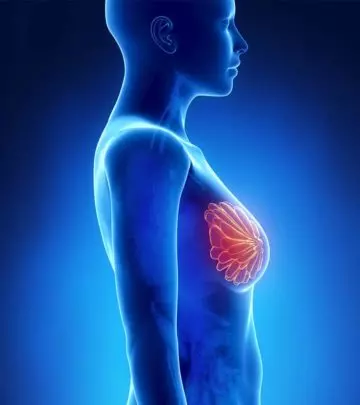
Image: Shutterstock
After all those hiccups related to weaning your baby, you must be wondering what really happens to your breasts and how all of a sudden they stop their milk production! Well, your breasts are a ball of fatty tissues enveloping an interlocked network of ducts. The epithelial cell lining of these ducts, triggered by hormonal signals, multiply to form tiny ball-like structures called alveoli that produce milk for the baby after they are born.
Once, you stop breastfeeding, there will be an accumulated pile of dead cells in your breasts. Cleaning up this debris of dead cells in your body is a huge task, which should naturally go to the department of your immune system.
But, you may be surprised to hear that your immune system is not given the entire charge of regenerating your breasts after you stop breastfeeding. Their role to ease the smooth functioning of the breasts is minimal. Had your immune system played an active role to play in the clearing up of this debris of dead cells and accumulated excessive quantities of milk, you would have had to experience the trauma of inflammation, pain and swelling. This is called as phagocytosis.
Phagocytosis is a Greek word which means ‘devouring cells’. Phagocytes are the first line of defense mechanism where the enzymes and the toxic peroxides in these cells digest the bacteria, dead cells and small mineral particles, thus boosting the body’s immune system.
Then what clears the debris of dead cells and milk from your breasts after you stop breast-feeding? Any guesses? Your own milky cells become cannibalistic eaters that devour other cells of its kind. Yes, your epithelial cells devour their dead neighbors thus clearing the debris in your breasts.
In an experiment using mice, Nasreen Akhthar at the University of Sheffield discovered that the protein called Rac 1 plays a vital role in the activity of regeneration as much as in the activity of milk production. She removed Rac 1 in some selected mice and found that the mice experienced severe inflammation and swelling in their breasts which were now fully loaded with milk.
Researchers also took a note of the fact that Rac 1 increased the mobilization of these dead cells into the milk ducts so that the process of regeneration is assured and made faster. This does not mean that Rac 1 ousts the activities of your immune system completely out of the breast box. Rather, Rac 1 makes it easier for the immune system to cleanse the breasts from the accumulated debris.
Hence, for a prolonged proper function of the breast tissues, this regeneration activity is utmost necessary and Rac 1 does most of the phagocytic activity. As Rac 1 keeps away the inflammation, it also helps the breasts transform again into milk-producing factories during the second pregnancy.
For the initial five to ten years following pregnancy, women are certainly at a higher risk of developing breast cancer, though prolonged breastfeeding activity helps keep this risk at bay. This modern research at the Sheffield University has opened up newer possibilities of research in curing breast cancer. As you can well guess, the research is now heading in the direction of Rac 1 which was largely ignored by the earlier researchers. Your breasts have their own unique ways of protecting and regenerating themselves. Keep smiling at the wonder that is your body!












